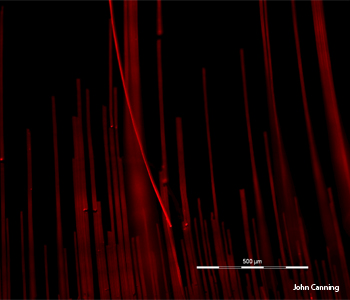
Self-assembled silica microwires, generated by an evaporative method.
By controlling the shape of water droplets with a UV laser, researchers from Australia and France found a way to coax silica nanoparticles to self-assemble into highly uniform silica wires as small as 100 μm in diameter (Opt. Matl. Exp. 3, 284) This technique is particularly significant, say the researchers, because it could enable silica to be combined with any material through a process of microwire self-assembly.
Last year, John Canning and others reported that tiny waveguides could be induced to self-assemble on hydrophilic glass slides using convective flow within an evaporating drop containing silica nanoparticles. In other work, they also reported that hydrophobic surfaces could be used to self-assemble silica nanoparticles into uniform large spheres. Both processes suggest that controlling the shape and volume of the water drop—including the angle at which the drop contacts the substrate—offer ways of controlling the properties of the self-assembled nanowires.
Now, the group from University of Sydney (Australia) and Institut de Chimie Moléculaire et des Matériaux d'Orsay (France) have used a 193 nm laser to both alter and pattern the surface properties of borosilicate slides. This enabled them to tune and control the contact angle of a water drop over the surface, which in turn allows them to alter the self-assembly of nanoparticles into straight microwires that can be used as light guides. They created both straight and tapered waveguides.
The ability to create microscale waveguides on different surfaces that are not amenable to more common deposition and patterning methods could offer a way to integrate photonics onto many attractive materials. The self-assembly method also offers a potential for functionalizing the waveguides to create active photonic devices.
